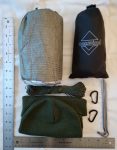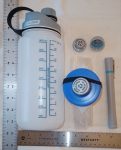(Continued From Part 1.)
Shelter/Warmth
The next area involves protecting her core body temperature, especially while sleeping at night. One important thing to keep in mind is that in New England it gets down into the lower 60s or upper 50s at night, even in the [1]summertime, and since you can get hypothermia at temperatures as high as 60 degrees you need to make sure you can stay warm and dry year-round. While there are various commercial and public buildings along most of her get-home routes that she could seek shelter in, I didn’t want to assume that would
I’ll be discussing specific seasonal considerations later on, but there are some items that should be included for all seasons.
- Poncho/Tarp [2] (7.7 oz.) – Used to stay dry when wearing or when set up as a shelter. I selected the OneWind one due to its light weight and decent size (89” x 56”). One modification I made for her was to add some ultralight tensioners [3] in the center of the two short sides to allow it to be strung up lengthwise as an a-frame. Other tarp/poncho options I considered were ones from Terrapin [4] and Sea-to-Summit [5], both of which were slightly larger, but heavier and a lot more expensive.
- Merino wool hat [6] (2 oz.) – This is good for keeping her head warm when it gets cooler at night.
- Silk long underwear (5.1 oz. for both) – A lightweight top [7] and bottom [8] that increases comfort on chilly late spring/summer/early fall nights.
- SOL Escape Bivvy [9] (8.9 oz.) – This is the outer layer of the sleep system. It’s relatively lightweight, waterproof, breathable and reflects 70% of your body heat back. It’s also a lot more durable than those cheap mylar ones, so it can handle quite a few nights. I’ve used one myself on numerous camping trips and it easily adds 10-20 degrees of warmth. One other advantage over the cheap mylar ones is that it makes a lot less noise when moving around inside it.
- 100′ of microcord [10] (1.4 oz.) – This can be used to rig a shelter and lot of other things. I pre-cut two 15’ lengths and attached a small aluminum carabiner [11] (.1 oz./ea.) to one end of each so she can quickly wrap it around a tree and run the free end through the tensioner on the poncho/tarp to rig it up. This stuff is rated at 100 lbs. tensile strength, which should be more than strong enough for any task she needs.
- 4 x titanium shepherd hook stakes [12] (.8 oz) – These are for staking down the corners of the shelter. Yes, she could find some sticks and carve some stakes, but that’s extra work that’s easily avoided with a minimal weight penalty.
 [13]If there’s a chance it may get cooler on some evenings another option I also suggested is a Puffer vest [14] (9 oz.) as an additional option to help keep her core warm, and it can pack down small into a 1L stuff sack [15], but the SOL bivvy should be able to handle most scenarios and I wasn’t sure the extra weight of the vest was worth it. Once she had all of the bits I spent a some time teaching her how to rig the poncho up in a-frame and snowplow configurations, showed her how she can use leaves or pine boughs to add some insulation and padding under the bivvy, rig one end of the a-frame against a tree and use her backpack to block the wind at the ends, and pile snow or debris up around the edges of the a-frame to block any cold breezes and help keep heat in.
[13]If there’s a chance it may get cooler on some evenings another option I also suggested is a Puffer vest [14] (9 oz.) as an additional option to help keep her core warm, and it can pack down small into a 1L stuff sack [15], but the SOL bivvy should be able to handle most scenarios and I wasn’t sure the extra weight of the vest was worth it. Once she had all of the bits I spent a some time teaching her how to rig the poncho up in a-frame and snowplow configurations, showed her how she can use leaves or pine boughs to add some insulation and padding under the bivvy, rig one end of the a-frame against a tree and use her backpack to block the wind at the ends, and pile snow or debris up around the edges of the a-frame to block any cold breezes and help keep heat in.
The weight for this module is 1.6 lbs. (25.7 oz.), bringing the total weight so far up to 5.4 lbs. (87.3 oz.). I realize that in some scenarios you could probably replace parts of this module with options such as building a debris shelter to keep warm, just using a cheap mylar or disposable poncho, etc., but this goes back to my requirements for something that requires minimal skills, has minimal external dependencies (e.g. debris) and can survive being reused for seven nights.
Fire
Closely related to warmth is the ability to start a fire. This is for heating water as well as for drying out and warming up if she gets wet or the temperature plunges unexpectedly. Starting a fire is one area that a lot of preppers invest a lot of effort into, and the basic gear that meets her needs is pretty light and compact.
- Bic mini lighter (.4 oz.) – For starting fires.
- Ferro rod [16] & scraper [17] (.15 oz. for both) – An alternative way to start a fire. I tied these together with an 8” piece of microcord so they won’t get lost.
- 8 x Procamptek Fire Plugs tinder [18] (.6 oz.) – Tinder in case there’s nothing readily available. These can be cut in half for starting small fires with twigs and catch easily with a good spark once they’re fluffed up.
- 4 x strips of magnesium (DNR) – These were cut from a roll of magnesium ribbon and can be ignited with ½ of one of the Procamptek starters. Very useful for starting a fire if you only have damp twigs.
- Wire saw [19] (.1 oz.) – For cutting larger pieces of wood if a bigger fire is necessary.
- Fire Escape Multitool Carabiner [20] (1.6 oz.) – This has a fire striker as well as a number of other useful functions. I recommended she carry this on her belt loop or other clothing attachment for easy access to the seat belt cutter/window breaker in the event of an emergency.
 [21]The weight is 2.8 oz., bringing the total up to 5.6 lbs. (90.1 oz.) The Swiss Army knife I discuss later on has a 3” saw blade for cutting smaller sticks and twigs if necessary.
[21]The weight is 2.8 oz., bringing the total up to 5.6 lbs. (90.1 oz.) The Swiss Army knife I discuss later on has a 3” saw blade for cutting smaller sticks and twigs if necessary.
Water
One good thing about New England is the availability of water – you can’t go more than a mile or two without running into a river, stream, lake or pond. Since she’s going to potentially be traveling in or near urban and suburban areas I wanted to make sure the water filter included an activated carbon element to remove chemicals, metals, etc. as well as biologicals.
- HydroBlu Sidekick water filter [22] (.5 oz.) – This is the smallest and lightest filter I could find that included a carbon element. The one downside is that it’s a straw-type filter, so it’s not designed to fill a water bottle. The good news is that there’s an easy hack you can do to make it into a squeeze filter (see next item). Note: Since I’m sure someone right now is thinking ‘What about a Sawyer Mini?’, keep in mind it weighs almost 3 times as much and doesn’t have an activated carbon element.
- 2 x Spare filter elements [23] (.1 oz./ea.) – These are each rated for up to 50 gallons, so that should provide plenty of water for any reasonable trip. Since I wanted her to have a squeeze-type filter to fill her water bottle, I removed the flap cover from the ends of each of these, drilled a 5/8” hole into a standard soda bottle cap and glued the input side of the filter element on to the cap using some JB Plastic Weld. Now she can plug the element into the bottom of the filter and screw the attached cap onto any 28mm source bottle and have a squeeze filter to fill her water bottle.
- Nalgene Cantene [24] (2.1 oz.) – This is a 32 oz. source water bottle that she can use as a squeeze bottle and to carry additional unfiltered water. To match the 28mm cap on the filter element I cut the spout off of a standard soda bottle (below the plastic rim), drilled a ¾” hole in the center of the Nalgene’s lid and glued the spout onto the lid with JB Plastic Weld. Now it’s a squeeze bottle that works with the hacked filter elements. If you’re wondering why I chose a wide-mouth bottle (which is slightly bulkier than a narrow mouth one), it’s because trying to fill a narrow-mouth soft sided water bottle in surface water (standing or moving) is extremely frustrating. If you don’t believe me try it in your bathtub sometime.
- Nalgene HDPE Wide Mouth BPA-Free Water Bottle [25] (5.2 oz. w/o water) – She always carries water with her, but she had a beat up old water bottle so I had her replace it with a new plastic 32 oz. Nalgene with a drink lid [26]. It’s lightweight and pretty tough. Note that 32 oz. of water weighs around 2 lbs., which I didn’t include in the weight calculations since that’ll vary depending on how full the bottle is.
 [27]This all adds 8 oz., not including the water itself, for an updated total of 6.1 lbs. (98.1 oz.). One other item I considered was a sillcock key since she’ll be moving through urban and commercial areas, but it’s heavy (6 oz.) and natural sources of water are readily available so I decided against it.
[27]This all adds 8 oz., not including the water itself, for an updated total of 6.1 lbs. (98.1 oz.). One other item I considered was a sillcock key since she’ll be moving through urban and commercial areas, but it’s heavy (6 oz.) and natural sources of water are readily available so I decided against it.
(To be continued, in Part 3.)